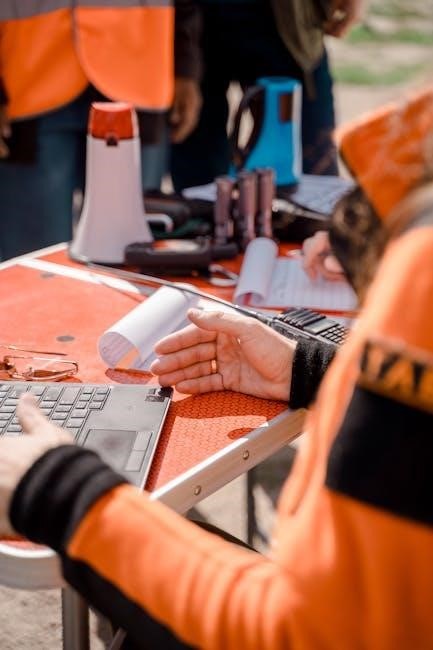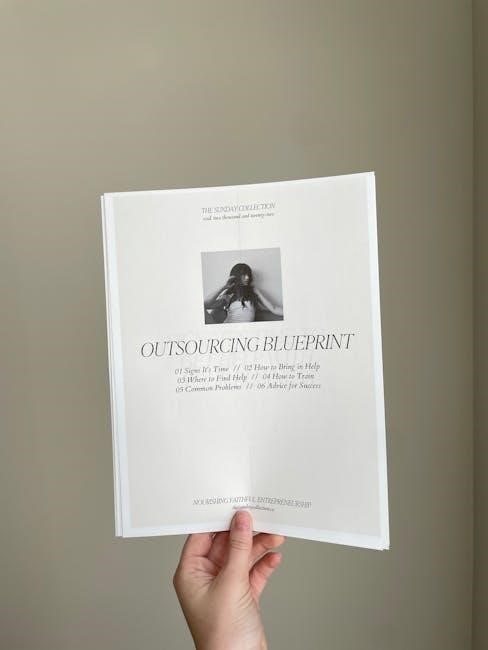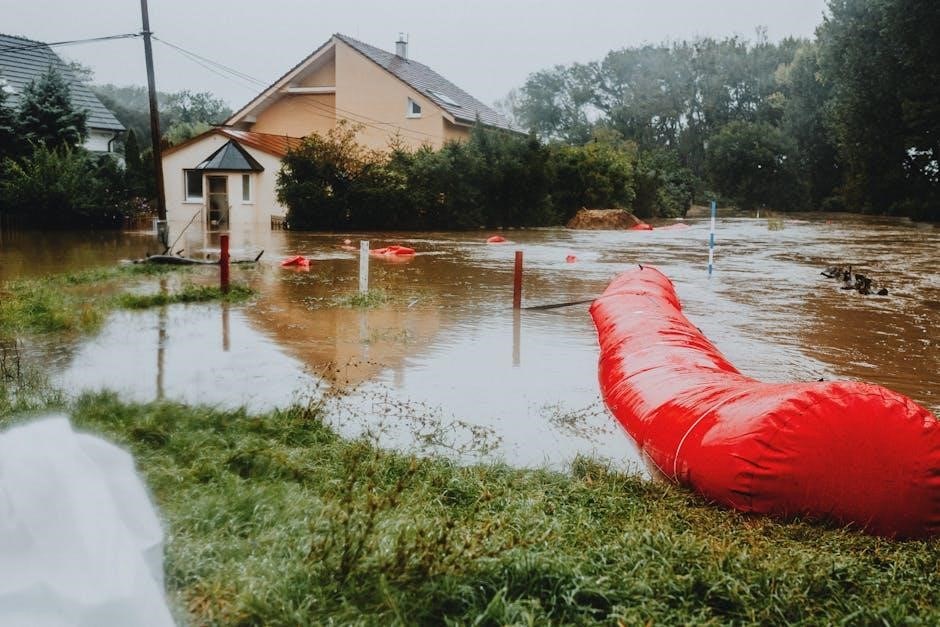The Iowa Stormwater Management Manual (ISWMM) provides comprehensive guidance for effective stormwater management in Iowa. It helps communities implement sustainable practices to protect water quality and infrastructure while meeting regulatory requirements. This resource is essential for urban and rural areas, offering practical tools and strategies to manage stormwater runoff efficiently.
Overview of the ISWMM
The Iowa Stormwater Management Manual (ISWMM) is a comprehensive resource designed to guide effective stormwater management practices across Iowa. It provides detailed guidance for urban and rural areas, addressing both water quality and quantity management. The manual emphasizes sustainable strategies to mitigate the impacts of stormwater runoff, such as flooding and pollution. It includes best management practices (BMPs), regulatory compliance, and technical tools to support local jurisdictions. The ISWMM serves as a critical reference for engineers, planners, and policymakers, offering practical solutions to stormwater challenges. By integrating scientific principles with local regulations, the manual ensures that communities can implement efficient and environmentally sound stormwater management systems tailored to Iowa’s unique conditions and needs.
Importance of Stormwater Management in Iowa
Stormwater management is crucial in Iowa to protect its natural resources and communities. The state’s agricultural landscapes and urban areas are vulnerable to runoff contamination, which can degrade water quality and harm aquatic ecosystems. Effective stormwater management prevents pollution, reduces flooding, and safeguards public health. It also supports economic stability by preserving infrastructure and ensuring regulatory compliance. By implementing sustainable practices, Iowa can maintain its water resources for future generations while addressing environmental challenges like climate change and urbanization. The Iowa Stormwater Management Manual plays a pivotal role in guiding these efforts, offering strategies to balance development with environmental stewardship and promote a resilient water management framework statewide.

Key Principles of Stormwater Management
Stormwater management focuses on mitigating runoff impacts through hydrologic balance, water quality protection, and best practices to ensure sustainable urban and rural development while safeguarding ecosystems.
Hydrologic Cycle and Stormwater Runoff
The hydrologic cycle describes the continuous movement of water on, above, and below the Earth’s surface. Precipitation, evapotranspiration, and infiltration are key components. Stormwater runoff occurs when precipitation flows over land, untreated, often carrying pollutants. In natural settings, much of this water infiltrates soil, replenishing groundwater. However, urbanization increases impervious surfaces, reducing infiltration and accelerating runoff. This intensifies flooding, erodes landscapes, and degrades water quality. Managing stormwater runoff is critical to mitigate these impacts, ensuring sustainable water resources and protecting ecosystems. The Iowa Stormwater Management Manual emphasizes understanding these processes to design effective strategies for runoff control and water quality protection.
Water Quality Protection
Water quality protection is a cornerstone of effective stormwater management. Stormwater runoff often carries pollutants like sediment, nutrients, and bacteria, which can degrade water bodies and harm aquatic life. The Iowa Stormwater Management Manual emphasizes the importance of implementing practices that reduce pollutant loads in stormwater runoff. This includes the use of best management practices (BMPs) such as vegetative buffers, detention ponds, and filtration systems. These strategies help mitigate the impact of urbanization on water quality by capturing and treating runoff before it enters waterways. Protecting water quality ensures the sustainability of Iowa’s rivers, lakes, and wetlands, supporting both human use and ecological health; The manual provides detailed guidance on designing and maintaining these systems to meet regulatory standards and achieve long-term water quality goals.
Stormwater Best Management Practices (BMPs)
Stormwater Best Management Practices (BMPs) are essential tools for managing runoff effectively. BMPs are techniques and strategies designed to reduce the quantity and improve the quality of stormwater runoff. They include both structural and non-structural measures. Structural BMPs, such as detention ponds, rain gardens, and green infrastructure, physically capture and treat runoff. Non-structural BMPs, like public education and pollution prevention, address the sources of pollution directly. BMPs are selected based on site-specific conditions, regulatory requirements, and community goals. The Iowa Stormwater Management Manual provides detailed guidance on selecting, designing, and maintaining BMPs to ensure their effectiveness. Proper implementation of BMPs not only protects water quality but also enhances community resilience and environmental sustainability. Regular maintenance is crucial to ensure the long-term performance of these practices.

Stormwater Management Practices
Stormwater management practices involve strategies to control runoff, protect water quality, and ensure sustainable drainage solutions, addressing both urban and rural environments effectively.
Structural Practices
Structural practices in stormwater management involve physical infrastructure designed to capture, store, and treat runoff. These include detention and retention ponds, bioswales, and permeable pavements. Such systems reduce peak flow and improve water quality by filtering pollutants. Green infrastructure, like rain gardens and green roofs, also falls under this category, enhancing urban sustainability. These practices are crucial for managing stormwater effectively, ensuring compliance with environmental regulations while protecting Iowa’s water resources. They are often combined with non-structural strategies to create comprehensive solutions tailored to specific sites and communities.
Non-Structural Practices
Non-structural practices focus on managing stormwater through policies, education, and land-use strategies rather than physical infrastructure. Techniques include public outreach programs, zoning regulations, and conservation tillage. These methods emphasize pollution prevention, reducing runoff at its source by promoting infiltration and minimizing impervious surfaces. They are cost-effective, complement structural measures, and foster community involvement in stormwater management. Such practices align with Iowa’s goals of preserving water quality and natural resources, making them a key component of comprehensive stormwater strategies. They also enhance environmental awareness and encourage sustainable land-use practices across urban and rural areas.
Low Impact Development (LID) Techniques
Low Impact Development (LID) techniques are innovative strategies that mimic natural hydrologic processes to manage stormwater runoff. These practices emphasize reducing impervious surfaces and promoting infiltration, evapotranspiration, and filtration. Common LID techniques include green roofs, permeable pavements, rain gardens, and bioswales. These methods help reduce peak flow rates, improve water quality, and enhance urban aesthetics. LID integrates seamlessly with urban planning, making it a sustainable solution for stormwater management in Iowa. By incorporating vegetation and natural processes, LID techniques also support biodiversity and mitigate the urban heat island effect. They are particularly effective in urban areas, where traditional infrastructure often struggles to manage increasing runoff volumes. LID aligns with Iowa’s environmental goals, offering a cost-effective and eco-friendly approach to stormwater management.

Regulatory Compliance and Standards
The Iowa Stormwater Management Manual ensures compliance with federal, state, and local regulations, guiding communities to meet water quality standards and reduce pollutant discharge into waterways effectively.
Federal Regulations
Federal regulations, particularly the Clean Water Act, play a crucial role in shaping stormwater management practices in Iowa. The Environmental Protection Agency (EPA) sets national standards to ensure water quality and reduce pollution. The Iowa Stormwater Management Manual aligns with these federal guidelines, emphasizing the importance of reducing pollutants in stormwater runoff. Key federal requirements include obtaining National Pollutant Discharge Elimination System (NPDES) permits for certain stormwater discharges, especially from industrial activities and construction sites. Municipalities must also comply with MS4 (Municipal Separate Storm Sewer System) permits, which mandate effective stormwater management to protect receiving waters. By adhering to these federal standards, Iowa communities ensure compliance while safeguarding environmental health and water resources for future generations.
State of Iowa Requirements
The State of Iowa has established specific requirements for stormwater management, complementing federal regulations. The Iowa Department of Natural Resources (DNR) oversees these standards, ensuring they align with the Iowa Stormwater Management Manual. Key state requirements include implementing best management practices (BMPs) tailored to Iowa’s unique hydrological conditions, particularly in urban and rural areas. Stormwater permits are mandatory for construction sites and industrial facilities, with strict erosion control and water quality measures. Municipalities must also maintain compliance with local ordinances and watershed management plans. By integrating state-specific guidelines, Iowa ensures effective stormwater management that addresses both water quality and quantity challenges, fostering sustainable environmental practices across the state. These requirements are regularly updated to reflect evolving environmental needs and scientific advancements in stormwater management.
Local Ordinances and Permitting
Local ordinances and permitting processes play a crucial role in implementing stormwater management strategies in Iowa. Municipalities and local governments are responsible for enforcing ordinances that align with state and federal regulations, ensuring compliance with the Iowa Stormwater Management Manual (ISWMM). These ordinances often include specific requirements for stormwater management practices, such as detention ponds, green infrastructure, and erosion control measures. Permitting processes are designed to ensure that development projects meet environmental standards, protecting water quality and reducing flood risks. Local jurisdictions may also conduct inspections and enforce penalties for non-compliance. By tailoring regulations to local conditions, communities can effectively manage stormwater runoff while adhering to broader state and federal guidelines. This localized approach ensures that stormwater management practices are both effective and adaptable to specific regional needs.

Technical Guidance for Implementing ISWMM
The ISWMM offers detailed technical guidance for implementing stormwater management practices, covering hydrology, water quality management, and BMP design to ensure effective and compliant stormwater solutions.
Hydrology and Hydraulics
Hydrology and hydraulics are critical components of stormwater management, focusing on the movement and behavior of water in natural and engineered systems. The Iowa Stormwater Management Manual (ISWMM) provides detailed guidance on assessing hydrologic conditions, including rainfall-runoff relationships and watershed dynamics. Hydraulic principles are applied to design stormwater infrastructure, such as culverts, channels, and detention ponds, ensuring they can handle flood events and maintain water quality. The manual emphasizes the use of hydrologic models and equations to predict runoff rates and volumes, enabling precise design and analysis. By integrating hydrology and hydraulics, practitioners can develop systems that effectively manage stormwater while minimizing environmental impacts. This section also addresses local challenges, such as Iowa’s intense rainfall patterns and agricultural land uses, ensuring tailored solutions for the state’s unique conditions.
Water Quality Management
Water quality management is a cornerstone of the Iowa Stormwater Management Manual (ISWMM), focusing on reducing pollutants in stormwater runoff to protect aquatic ecosystems. The manual emphasizes best management practices (BMPs) such as green infrastructure, filtration systems, and detention basins to minimize contaminants entering water bodies. It also highlights the importance of regular monitoring to assess the effectiveness of these practices. The ISWMM aligns with the Clean Water Act, ensuring compliance with federal and state water quality standards. By prioritizing source control and treatment, the manual helps communities maintain healthy waterways and promote biodiversity. Public education and outreach are also integral, fostering awareness of the role individuals play in preserving water quality.
Design of BMPs
The Iowa Stormwater Management Manual (ISWMM) provides detailed guidance on the design of Best Management Practices (BMPs) to effectively manage stormwater runoff. BMPs are structured to reduce runoff volume, peak flow, and pollutant loads. The manual outlines design criteria for various BMPs, including vegetative practices like biofiltration and structural practices such as detention ponds. It emphasizes the importance of site-specific design considerations, including soil type, drainage area, and land use. The ISWMM also offers tools for hydrologic and hydraulic analysis to ensure BMPs perform efficiently. Proper design not only enhances water quality but also supports community resilience and environmental sustainability. By adhering to these guidelines, practitioners can implement BMPs that meet regulatory standards and protect Iowa’s water resources effectively.

Case Studies and Examples
The Iowa Stormwater Management Manual includes real-world examples and case studies demonstrating successful stormwater management strategies in urban and rural Iowa, highlighting effective BMP implementations and outcomes.
Successful Stormwater Management Projects
The Iowa Stormwater Management Manual highlights successful projects that demonstrate effective stormwater management strategies. These case studies showcase urban and rural applications, emphasizing best management practices (BMPs) like permeable pavements, rain gardens, and bioswales. For example, a downtown revitalization project in Des Moines utilized green infrastructure to reduce stormwater runoff by 40%, improving water quality in nearby rivers. Similarly, a rural watershed initiative implemented conservation tillage and buffer strips, decreasing nutrient runoff and enhancing soil health. These projects illustrate how adherence to ISWMM guidelines can lead to sustainable, environmentally beneficial outcomes, serving as models for future stormwater management efforts across Iowa.
Urban Stormwater Management Examples
Urban areas in Iowa have implemented innovative stormwater management practices to address runoff challenges. Cities like Cedar Rapids and Davenport have adopted green infrastructure, such as permeable pavements and bioswales, to reduce flooding and improve water quality. In Cedar Rapids, a downtown parking lot was retrofitted with permeable pavers, reducing stormwater runoff by 50%. Similarly, Davenport integrated bioswales along streets to capture and filter rainwater, enhancing urban aesthetics while mitigating drainage issues. These projects align with the Iowa Stormwater Management Manual’s guidelines, showcasing how urban communities can effectively manage stormwater while promoting sustainable development and environmental stewardship. These examples serve as valuable models for other cities seeking to implement similar solutions.
Rural Stormwater Management Examples
Rural areas in Iowa have successfully implemented stormwater management strategies tailored to agricultural and natural landscapes. Vegetated biofilters, such as buffer strips and prairie restorations, are widely used to reduce runoff and improve water quality. For instance, conservation tillage practices in rural fields minimize soil erosion while allowing rainwater to infiltrate the ground. Additionally, wetland restoration projects in rural regions help capture and filter stormwater, reducing nutrient runoff into waterways. These practices not only protect the environment but also align with the Iowa Stormwater Management Manual’s goals of promoting sustainable land use and water resource management. Such examples demonstrate how rural communities can effectively balance agricultural productivity with environmental stewardship, ensuring long-term water quality and ecosystem health.

Resources and Tools for Practitioners
The ISWMM offers various tools and resources, including software like SWMM for hydrologic modeling, guidance documents, and partnerships with agencies like the Iowa DNR to support effective stormwater management practices.

Supportive Organizations and Agencies
The Iowa Stormwater Management Manual (ISWMM) is supported by various organizations and agencies that provide resources and expertise. The Iowa Department of Natural Resources (DNR) plays a key role in regulating and guiding stormwater practices. Additionally, the Iowa Department of Transportation (DOT) offers insights into managing stormwater in transportation systems. Other agencies, such as the Iowa Department of Agriculture and Land Stewardship (IDALS), contribute by addressing agricultural impacts on water quality.
These partnerships ensure that practitioners have access to updated guidelines, technical assistance, and funding opportunities. By collaborating with these organizations, communities can effectively implement stormwater management strategies that align with state and federal regulations.
Practitioners can also use search queries to find specific resources, such as “Iowa stormwater management manual” or “stormwater BMPs,” to locate relevant tools and guidelines efficiently.
Such collaborations and resources empower communities to adopt sustainable stormwater practices, ensuring environmental protection and compliance with regulatory standards.
Software Tools for Stormwater Analysis
Various software tools are available to support stormwater analysis and management in Iowa. The Stormwater Management Model (SWMM) is widely used for simulating urban drainage systems and analyzing runoff quality and quantity. Additionally, tools like the Iowa DNR’s online calculators and the EPA’s National Stormwater Calculator provide resources for designing best management practices (BMPs) and assessing water quality impacts.
These tools enable practitioners to model hydrologic and hydraulic processes, evaluate different scenarios, and ensure compliance with regulatory standards. They also facilitate the integration of low-impact development (LID) techniques and green infrastructure into stormwater management plans.
By leveraging these software tools, professionals can make informed decisions and implement effective strategies for managing stormwater in both urban and rural settings, aligning with the guidelines outlined in the ISWMM.

Public Education and Outreach Materials
Public education and outreach materials play a crucial role in promoting stormwater management practices in Iowa. The Iowa Stormwater Management Manual (ISWMM) emphasizes the importance of educating residents, businesses, and local governments about the impacts of stormwater runoff and the benefits of proper management. These materials include brochures, guides, and online resources that provide practical tips for reducing pollution and implementing best management practices (BMPs).
Additionally, outreach programs often incorporate visual aids, workshops, and community events to engage the public. These efforts aim to empower individuals and communities to take an active role in protecting water quality and reducing flood risks. By fostering awareness and participation, public education materials help align local actions with the ISWMM’s goals, ensuring a more sustainable and resilient water resource management system across Iowa.

Future Trends in Stormwater Management
Future trends in stormwater management emphasize innovative technologies, climate resilience, and integrated approaches. Emerging tools like smart sensors and green infrastructure are expected to enhance efficiency and sustainability.
Emerging Technologies
Emerging technologies are transforming stormwater management by enhancing efficiency and sustainability. Smart sensors and IoT devices enable real-time monitoring of water quality and flow, allowing for proactive management. Artificial intelligence (AI) and machine learning optimize predictive modeling for better stormwater runoff predictions. Green infrastructure, such as biofiltration systems, integrates seamlessly with urban planning, reducing runoff and improving water quality. Advanced data analytics tools help practitioners make informed decisions, while low-impact development (LID) techniques promote environmentally friendly solutions. These innovations align with Iowa’s goals to adapt to climate change and integrate water resource management. By embracing these technologies, Iowa communities can achieve sustainable and resilient stormwater systems, ensuring long-term environmental and economic benefits.
Climate Change Adaptation
Climate change poses significant challenges for stormwater management in Iowa, with rising temperatures and increased precipitation intensity. Projections indicate more frequent and intense rainfall events, leading to heightened flood risks and infrastructure strain. Adaptation strategies are critical to building resilience. The ISWMM emphasizes integrating climate-resilient designs, such as green infrastructure and adaptive stormwater systems, to manage increased runoff. By incorporating predictive modeling and smart technologies, communities can better anticipate and respond to extreme weather events. These measures ensure long-term sustainability and protection of Iowa’s water resources, aligning with broader climate adaptation goals. Proactive planning and innovative solutions are essential to mitigate the impacts of climate change on stormwater systems, ensuring safer and more resilient communities.
Integrated Water Resource Management
Integrated Water Resource Management (IWRM) is a holistic approach to managing water resources, ensuring sustainability, equity, and efficiency. The Iowa Stormwater Management Manual (ISWMM) aligns with IWRM principles by promoting coordination across sectors and stakeholder involvement. This approach addresses water quantity and quality, balancing human needs with environmental protection. IWRM strategies in Iowa focus on optimizing water use, reducing pollution, and enhancing watershed health. By integrating stormwater management with broader water resource planning, communities can achieve long-term water security and resilience. The ISWMM provides tools and guidelines to support IWRM, fostering collaboration and adaptive management practices; This ensures that stormwater systems contribute to overall water resource sustainability, benefiting both urban and rural areas while protecting Iowa’s ecosystems. The manual emphasizes the importance of a cohesive strategy to meet current and future water challenges effectively.
